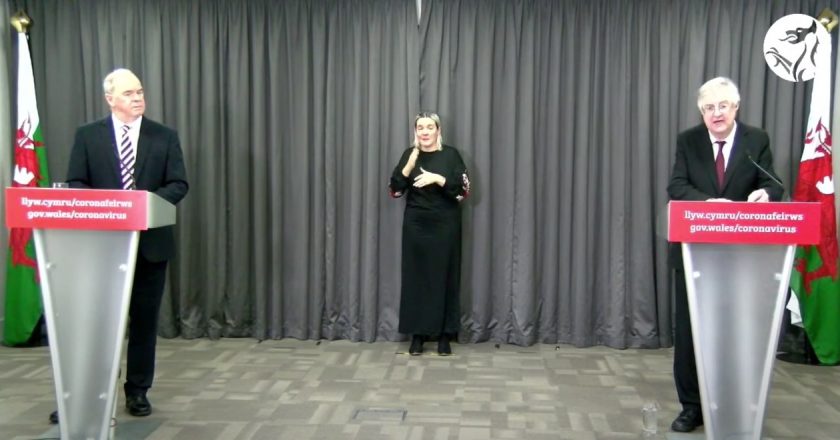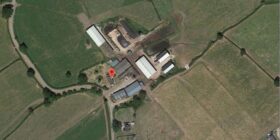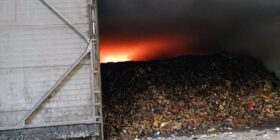New virus variant “looks very likely to be a significant driver of the huge growth” in Wales – as Wrexham hits 445.7 per 100k figure

The Deputy Chief Medical Officer has said 22% of samples in North Wales have demonstrated the new coronavirus variant, and that is ‘increasing’.
Today Wrexham reported +126 new cases on the Public Health Wales dashboard update with a 20.7% positive proportion of tests, taking commonly used seven day rolling benchmark figure to 445.7 per 100k.
Today’s briefing was unusual as it had both the First Minister Mark Drakeford and Deputy Chief Medical Officer (DCMO), Professor Chris Jones, at the podiums.
The First Minister opened, “Today I had hoped to be looking forward to better times in 2021. Unfortunately, I need instead to talk to you about the latest challenge we are facing. As you will have heard over the last few days, a new mutated strain of coronavirus has been identified. It is much more infectious and it is moving quickly in Wales.”
The DCMO said, “The first thing to say is that all viruses can and do change. Genetic mutations are a natural phenomenon of viruses and the coronavirus is no different. We’ve seen a number of mutations since the SARS-COVID-2 virus was first identified in Wuhan just over a year ago and most of these mutations turn out to have no significance.”
“But, this new strain of the coronavirus which has been detected in the UK and to other countries, is concerning. We are mainly saying it in London, and the southeast of England, but also in Wales. The way the virus has spread rapidly in these areas is very similar. This new strain appears to be much more infectious than the strain which originated in Wuhan, and is much more easily transmitted from person to person.
“At this stage we do not believe that it causes a more serious illness than what we already understand. We do not believe that it will affect how the vaccine works. We will continue to closely monitor this new variant and what the scientific evidence is telling us.”
“On Monday of last week we were aware of 10 cases in Wales, by Friday this had risen to 20, mainly around Bridgend and the Vale of Glamorgan. A new analysis by the weekend suggested this new strain is much more common, and is present all over Wales. This includes North Wales, even though overall rates of the virus are lower than they are in South Wales.”
“The Office for National Statistics over the weekend, published data from its infection survey that shows the new strain was present in 28% of samples from Wales. In the second week of December, more than double the number in the previous week. Public Health Wales colleagues advise us that they feel this new strain could be causing up to 60% of coronavirus infections in Wales. This new variant looks very likely to be a significant driver of the huge growth in cases we’ve seen in Wales in recent weeks.”
The First Minister added, “While 2020 has been an extra ordinary year and a very difficult one for us all. This is a pandemic that has been full of surprises. And it’s taken another deeply unpleasant turn, just as we were preparing to celebrate Christmas. This new strain is a challenge for us all. But it is another challenge that we will manage together. ”
The DCMO did mention the situation in North Wales, saying of samples that “22% demonstrated the variant” and ‘that was increasing’. The Daily Post asked for further details on the new variant, and North Wales, and was told:
“Over the weekend Public Health Wales colleagues were able to undertake an analysis of the samples from Wales that have gone to lighthouse labs that can recognise this variant. That amounted to about 6000 in total of around 42,000 cases from earlier this month in Wales, and of the North Wales samples, 22% demonstrated the variance. Now that is not to say that is the prevalence now, because I think as we’re indicating, this is increasing. But it does provide some sort of indication and that that’s consistent with the ONS estimate of between 20 and 30% earlier in December, but I don’t have any figures about where in North Wales those samples came from.”
After, we used our two questions to ask for further clarity on when the Welsh Government was first aware of the issue. Earlier in the briefing the DCMO and First Minister were asked about the ‘late’ stage decision change over Christmas rules, and in his answer the DCMO said “…the issue of the new virus variant is very very recent indeed. We only need to know about such variants when they sort of ‘take off’ and demonstrate their competitive success against the previous versions of the virus. And that only became clear at the end of last week, over 60% of cases in London are now due to this virus variant. I think once you know that you know that this is a highly transmissible agent, and that it will just take off and our figures will just get worse, unless you take immediate action and that clearly happened over the weekend.”
We pointed to the UK Government briefing over the weekend where their chief scientific advisor Sir Patrick Vallance said, “…the new variant was first thought to have occurred sometime in mid-September in London or Kent. And by the middle of November, about 28% or so of the cases in London and the Southeast and slightly lower in the East of England were due to the new variant. So, it had grown rapidly. By the week commencing the 9th of December, these figures were much higher. So, in London, over 60% of all the cases were the new variant.”
We asked if there was an issue on information supply from UK Government to Wales, and asked the First Minister if Welsh Government needed to embed people in meetings at a lower level to get earlier intelligence.
The DCMO said “We are fortunate in the UK to have the genomics UK consortium which is a collaborative effort to undertake surveillance of different gene sequence of viruses circulating. That mechanism is operating all the time and Wales is a significant contributor of samples to that system. Variants come and go, all the time. When the CMOS updated Dr Frank Atherton on Monday, I think there was a suggestion that this virus was more transmissible than the previous virus variant, but that was still with low confidence.
“That situation clearly changed, NERVTAG undertook sequential risk assessments last week, and it was only after they met on Friday, that they said that this is now becoming the dominant virus variant. So, at the time when the emergence of this variant as a very significant contributor to increasing case rates in London in the southeast became apparent, then that information was shared with us.”
The First Minister explained, “I don’t think we know any less in Wales because anything was being kept from us. What we’ve learned is that it’s only two of the lighthouse labs that the test they use happens they pick up this variant. So, how much you know about a local population depends very much on how many tests from any one locality happens to be going to those two labs.”
“So one of the reasons why we know a fair bit about North Wales, is that quite a lot of the tests from North Wales go to the Birmingham lab, which is one of the two labs able to detect this variation. From South Wales far fewer tests, proportionately, have gone to the Milton Keynes which is the second lab that offers it.”
“So I don’t think it’s because anything has been kept from us. I think it is simply just a matter of how many tests ended up going to one of the two labs, able to identify it.”
“Here in Wales as Dr. Jones said, we’ve had we have our own genomic sequencing capacity. I think I’m right in saying that the United States has done the most genomic sequencing, England has done the next most and Wales is the third in the world in the amount of genomic sequencing that we have been able to carry out, and some of those very early numbers came to us, not because of Lighthouse Lab capacity, but because of things that were being picked up through our own genomic sequencing.”
Our second question referenced our story over the weekend that North Wales saw just 12% of vaccinations in the first tranches of roll out, at the time we were told the split across Wales was ‘based on the relative size of the priority population(s) in each of these areas’.
We asked if the roll out was going to increase sharply, and if North Wales really had just 12% of the priority population in Wales.
The First Minister replied, “You can be sure North Wales has absolutely its population share of the vaccine we have, and Wales has a population share of the UK supply.”
“So whatever comes into the UK, we get our fair share and then we try and make sure that every part of Wales has its fair share, as well. As you will know, some of the pioneering work that’s been done in relation to care home visiting has been happening in North Wales in a way that hasn’t been available elsewhere.
“We are dependent on complex supply chains of the UK Government has the lead in in making sure that vaccine does come into the United Kingdom, you’ll have heard some reports over night of some military preparation to make sure that if other routes into the UK are temporarily suspended because of the new variant, it will still be possible just to fly into Wales supplies of a Pfizer vaccine from Belgium.”
“We remain hopeful, I mustn’t overstated it, that the Oxford vaccine will get regulatory approval soon and then we will have more rapid numbers available including the work that is being done in Wrexham to supply, what will then be the whole of United Kingdom.”
As usual you can view the full briefing and Q&A session on the below video:
Cynhadledd i’r Wasg yn fyw nawr | Live Press Conference https://t.co/qtKq0lz3hF
— Welsh Government (@WelshGovernment) December 21, 2020
Spotted something? Got a story? Email [email protected]












